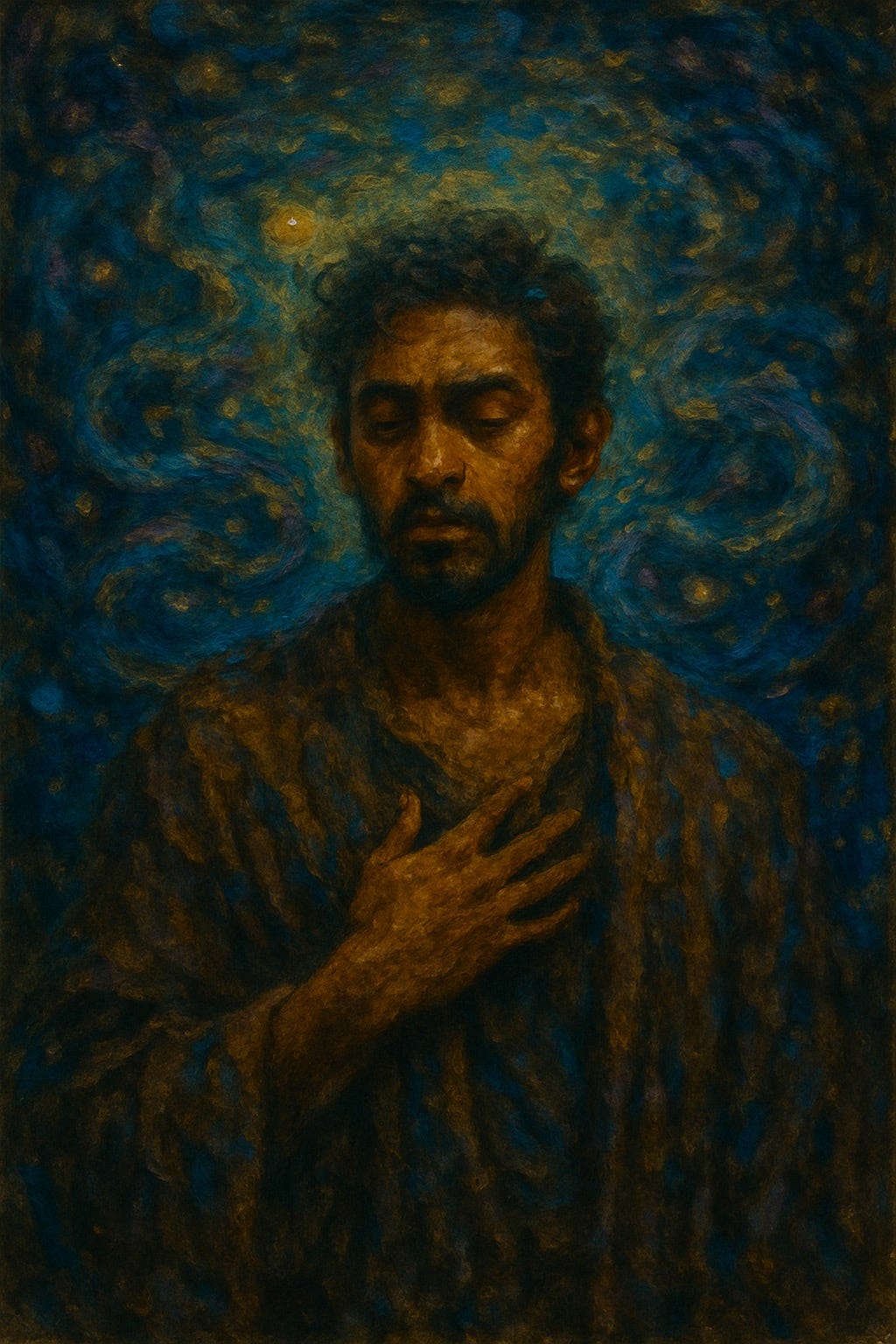Love, as Most People Live It, Is a Trauma Pattern
Most people don’t know what love is. They think they do, because they’ve felt chemistry, longing, heartbreak, or deep attachment. They’ve had moments that felt electric. They’ve stayed up late analyzing text messages. They’ve cried in parking lots and called it devotion. But in reality, most of what people call love is a trauma pattern trying to resolve itself through another human being.
The confusion starts early. You’re not taught what love is—you’re taught what earns it. Be good. Be easy. Be impressive. Don’t be too much. Don’t have needs. Don’t make a mess. From that point forward, love becomes transactional. It’s not something you rest into—it’s something you perform for. The person who hurt you or withheld connection becomes the blueprint, and every relationship after that becomes a subconscious attempt to get them to love you the way they never did. You call that chemistry. You call it fate. It’s neither.
People don’t enter relationships from clarity. They enter from the nervous system. They walk into intimacy with a blueprint shaped by fear, and then wonder why it breaks. The pain feels familiar, so they trust it. The chaos feels alive, so they mistake it for passion. They confuse being needed with being loved, being chosen with being seen, being triggered with being known. None of it is love. It’s just distortion that hasn’t been interrupted yet.
One of the most common distortions is what I call the performance pattern—when love is something you feel you have to earn. In this pattern, the relationship becomes a stage. You over-function. You manage their moods. You stay quiet about your needs so you don’t rock the boat. You make yourself indispensable. You’re endlessly supportive, understanding, and adaptable. But none of it is rooted in genuine self-expression. It’s all a strategy to not be left. And when it doesn’t work—when the person doesn’t show up, or leaves anyway—you feel betrayed, not just by them, but by love itself. Because you did everything “right,” and it still wasn’t enough. The truth is, you were never being yourself to begin with. You were being who you hoped they’d want.
Another distortion shows up in the need to be chosen. This one’s harder to catch, because it often masquerades as romance. It looks like waiting for someone who won’t commit. It looks like needing closure, needing to be understood, needing them to come back and finally see you clearly. In this dynamic, you are always positioning yourself as the exception—the one they’ll return to, the one who finally gets through to them. But what you’re actually doing is handing over your self-worth to the outcome of their behavior. You confuse their indecision for your unworthiness. You try to turn rejection into redemption. And you stay—physically or emotionally—not because it’s love, but because if they change, it proves you were worth it all along.
Then there’s the fixer distortion—when you love people for their potential. This one feels noble. You see what someone could be, and you want to help them get there. You pour yourself into their healing. You support, explain, rationalize, and endure. But if you’re honest, you’re not in love with the person—they’re often emotionally unavailable, immature, or inconsistent. You’re in love with the fantasy of who they might become. You see yourself as the person who will make the difference. But real love isn’t a rescue mission. It doesn’t require you to abandon yourself in order to bring someone else back to life. That’s not love. That’s ego.
The final distortion is the one most people defend to the end: chemistry. You feel it instantly. It’s magnetic. Unexplainable. You meet someone and your whole body lights up. It feels spiritual, cosmic, like you’ve known them forever. But what you’re actually feeling is a nervous system activation. That spark you call passion is often anxiety in disguise. It’s the body’s recognition of a familiar pattern. Not safe. Just familiar. The chaos you grew up with becomes the emotional frequency you now associate with love. So when someone offers you something steady and calm, you feel nothing—and call it boredom. When in reality, you’ve never experienced real safety before, so it doesn’t register as love.
Real love doesn’t feel like adrenaline. It feels like alignment. It doesn’t make you prove yourself, shrink yourself, or fix someone else. It doesn’t make you chase, perform, or compromise your integrity. Real love isn’t explosive. It’s clear. It’s grounded. It’s chosen. It grows, not because you need it to heal you, but because you already know who you are without it.
If you’ve never experienced that kind of love, it’s not your fault. Most people haven’t. Most people are still trying to reenact their first wound with someone who looks and sounds different. And because the world rewards those distortions—writes songs about them, builds movies around them, calls them romantic—they don’t get questioned. They get spiritualized. And so the patterns continue.
But if you find yourself exhausted, confused, insecure, constantly seeking proof that you matter in someone’s life—you’re not in love. You’re in distortion. The pain you feel is your nervous system begging you to stop calling it love. The chaos you’re managing is not a test of devotion—it’s a symptom of disconnection.
Love that requires you to abandon yourself isn’t love. It’s a reenactment.
And the longer you defend the pattern, the further away real love stays.
The Hidden Cost of the Love Pattern
The truth is, most people don’t want real love—not at first. They want relief. They want the ache to stop. They want to feel worthy, chosen, desired, important. And they’ve been conditioned to believe that love, when it finally arrives, will make all the inner noise go silent. That’s the setup. They don’t actually want connection—they want a cure. And when the person in front of them doesn’t act as a cure, they either try to control them, fix them, or leave them. That cycle becomes the love story. It’s not intimacy. It’s outsourcing self-worth to another nervous system and calling it romance.
If someone finally offers them real love—clean, stable, non-performative—it feels wrong. They say it’s “too easy” or “not exciting” or “something’s missing.” What’s actually missing is the chaos they used to call chemistry. The emotional volatility. The highs and lows that temporarily validated their value. Without that feedback loop, they don’t feel alive. Because the body only knows how to orient in familiar trauma—not peace. So they sabotage the very thing they said they were ready for, and then tell themselves a story about why it just didn’t work. That story usually centers around the other person not being “enough.” But what was actually “not enough” was the absence of their own wound to orbit around.
This is the unspoken cost of unresolved love distortion: your nervous system becomes addicted to confusion. You don’t trust what’s clear. You don’t recognize what’s healthy. You think a relationship has to challenge you in order to be real. But what’s actually happening is you’re filtering all connection through the unhealed belief that love is something you must chase, manage, or suffer for. As long as that belief is in charge, you will either chase emotionally unavailable people or become emotionally unavailable yourself. That’s not dysfunction. That’s architecture. It’s how the distortion is built.
This architecture doesn’t dissolve just because you become conscious of it. You can know the pattern inside and out—name it, journal about it, even teach it—and still unconsciously recreate it the next time someone triggers your unresolved need to be chosen. That’s the trap. Most people intellectualize the distortion but never stop participating in it. Because the truth is, clarity is boring to a system wired for instability. Peace feels flat when you’ve only ever known stimulation.
And here’s the hardest part for most people to swallow: you can heal the pattern and still find yourself grieving what it used to feel like. The chaos. The intensity. The constant need for approval. When you stop chasing love as a solution, there’s an emptiness that surfaces. It’s not because something is wrong—it’s because the addiction is wearing off. That grief isn’t evidence that the clarity is wrong. It’s evidence that the distortion is dying.
From here, a choice gets made. Some people go back. They find a new version of the same dynamic and convince themselves this time is different. Others stay in the space of clarity long enough to let their nervous system recalibrate. They get uncomfortable, they get bored, they get triggered by stability—but they don’t run. And eventually, they stop trying to earn love and start choosing it. That’s the moment everything changes. Not because someone else showed up differently—but because they finally did.
The entire pattern has one lie at the root:
“Love is something outside of me that will fix the part of me I’ve never accepted.”
That belief drives the whole machine. And until it’s dismantled, no amount of insight or desire or intention will make a difference. The architecture will rebuild itself in the next person, the next story, the next high.
And it’s that same lie that sets people up for the next distortion—how they assign their value to what they can get, earn, or keep. That’s where love becomes scarcity.
That’s where connection becomes currency.
And that’s where you forget:
You were never meant to be earned.
You were meant to be known.









